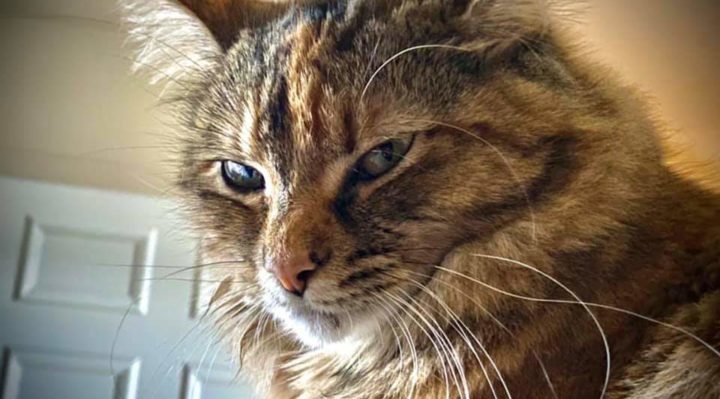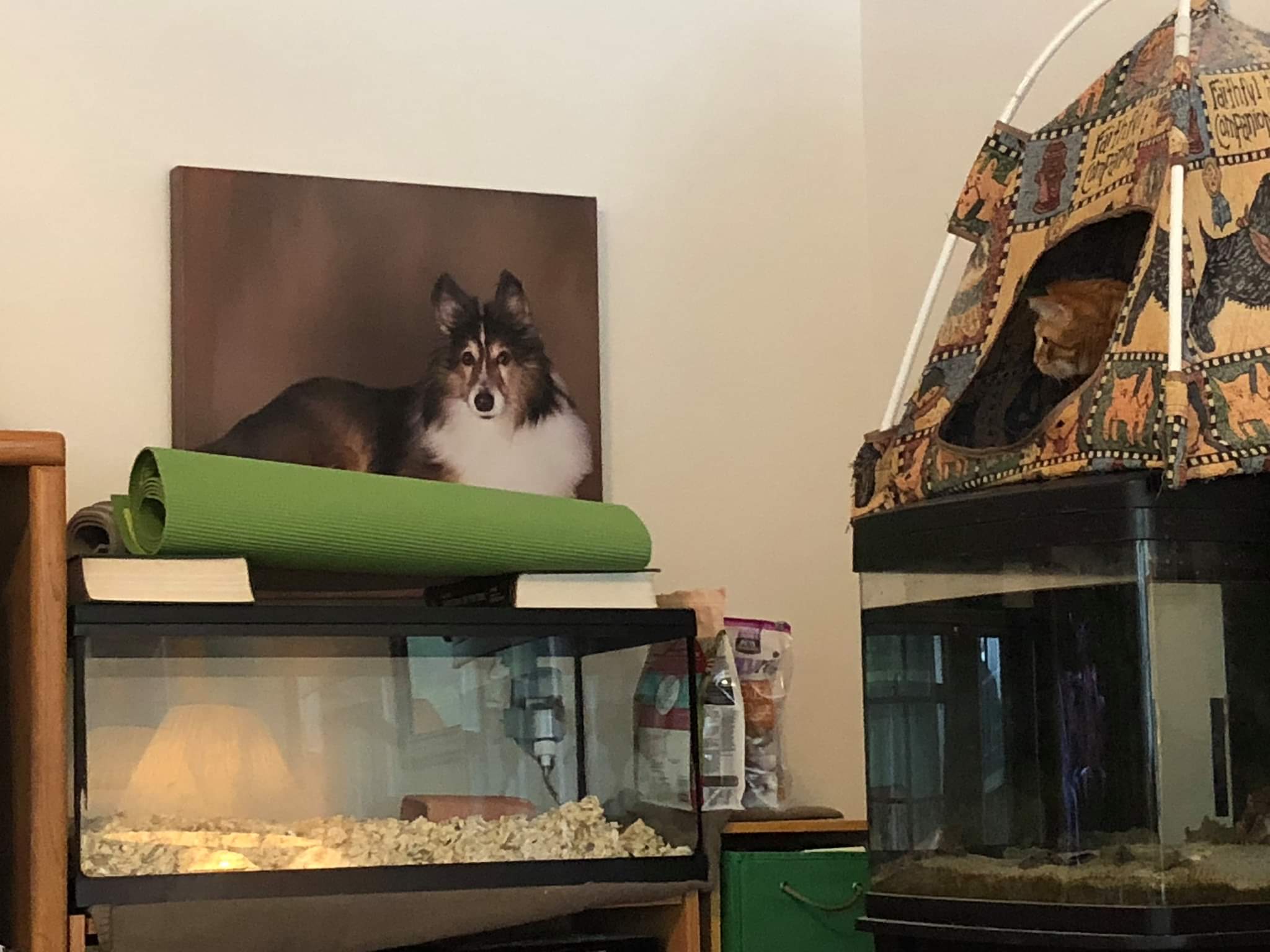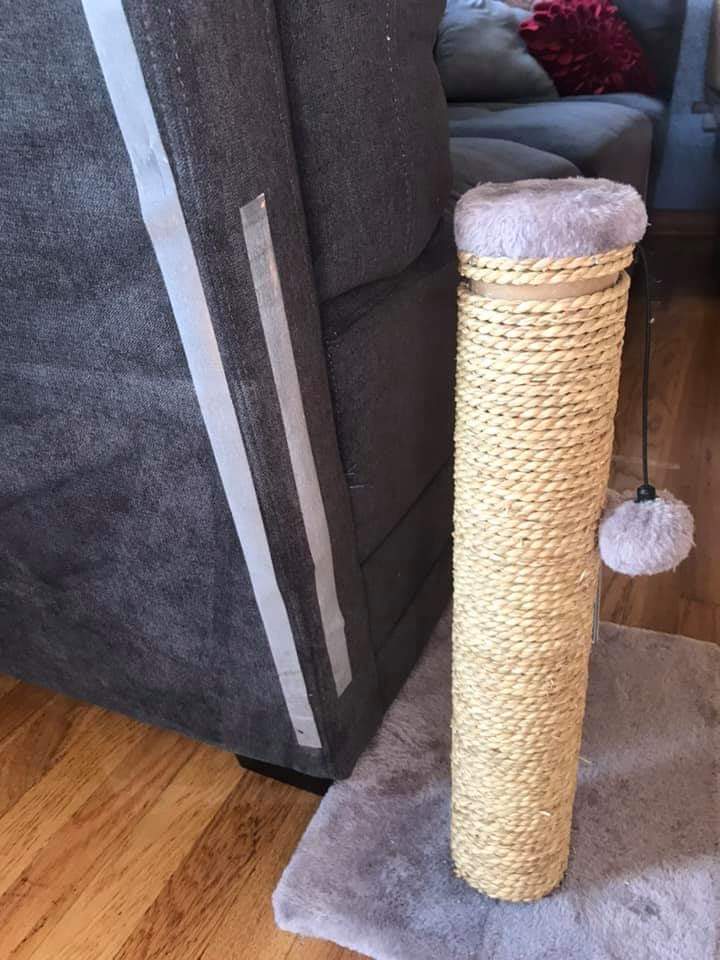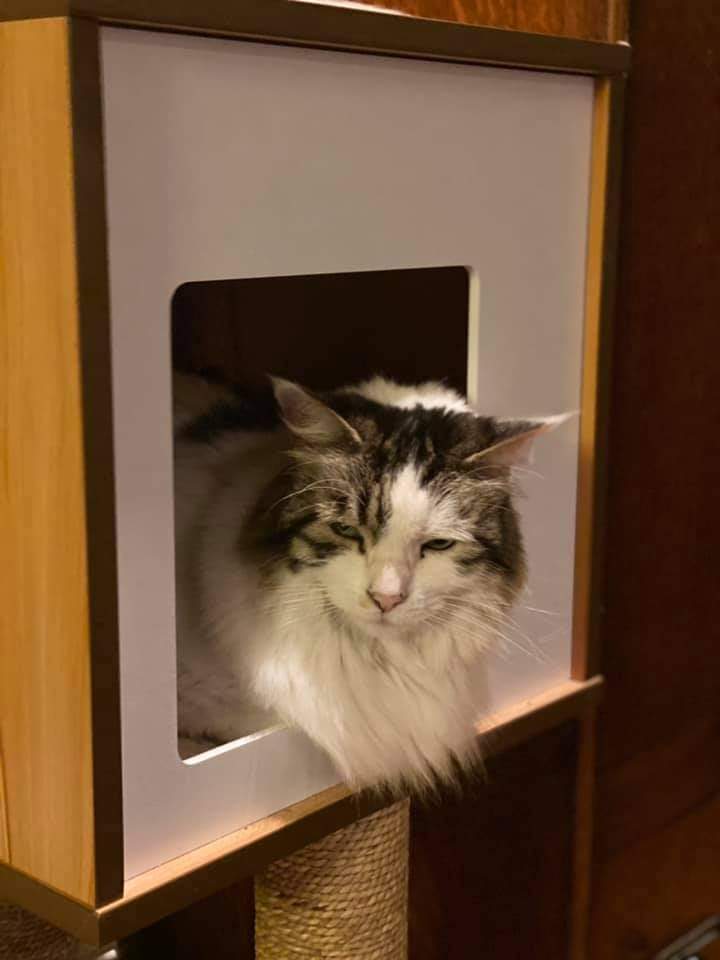
When my current cat joined our family some years ago, it had been a while since a cat had resided with us. The two previous cats had both lived to over age 21, with the general difficulties that most animals experience as they age. I had sworn never to have another cat because I thought my golden retriever was allergic to them. As it turned out, he was not—lucky for all of us, as the cat we adopted eventually became my golden’s very best friend. She saw him through his old age while we hospiced him for worn-out kidneys until he passed at age 15. My oldest dog ever . . . until the one who’s now 19.
With no cats in my home for such a long time, I had certainly forgotten how to cat-proof a house.
The new cat was going to be, I’d decided before she first arrived, an indoor-only cat. That would mean making her indoor-only environment not only enriching but also as safe as possible, since she might do some “thrill-seeking” as she settled into her adult years with us. (She was an adolescent at the time she arrived.)
What “bad” behaviors did our usually angelic young cat display, to my surprise? House plants! She ate ’em, or worse—she chewed off the edges of their leaves . . . which didn’t seem to upset her digestion in any way as far as I could tell. It wasn’t healthy for the plants, of course, and left them looking too tattered to display.
Within weeks, I remembered all the cat-proof places that plants could thrive in our house, like on a high window ledge above the stairs. That is, until the leaves droop so far off the ledge that they are only a few feet away for a high-jumping cat. And our new cat could certainly jump!
Plants hanging from hooks on the ceiling took the prize, but I definitely had to close the door when I watered plants in the bathroom sink. Doors can be very handy in cat-proofing a house, but you must remember to use them consistently, every time “something” might be in jeopardy of cat molestation.
It’s that one time you forget that “trains” you to be more vigilant.
Our new cat wasn’t into treats—not cat treats or anything other than cat kibble to eat, period. I had to guess she’d never been exposed to enticing cat edibles of any sort. It took years, but finally she decided that small pieces of “human” food are yummy—potato chips, goldfish crackers, and cereal in the shape of Os from Trader Joe’s. She still has absolutely no interest in commercial pet treats!
When she was new to us, she could easily leap from the edge of the bed onto the top of my dresser, where a container of dog treats lived. It had been kept there for years, a sentimental favorite—it had been a prize at a dog show I’d attended many dogs before. Dogs (at least the big ones) could have put paws on the dresser to illegally access those treats; the top of the container didn’t even screw on.
Keep in mind that the cat had no interest in eating the treats, so I still do not know why she frequently jumped up on the dresser and knocked the container on its side, spilling treats and crumbs all over. It’s possible that the dogs got enough of the crumbs off the floor to encourage them to urge the cat on. I saw no evidence of any overt urging, but there must have been some reward in it for the cat or she wouldn’t have continued the behavior. Maybe it was just a matter of “being able to do it” for her?
Needless to say, it took me much longer than it should have to solve that problem. I found in a cupboard downstairs a great old glass jar with a “locking” lid; it was perfect because (a) it held more treats; and (b) it was impossible to “unlock” for any animal without opposable thumbs or a fair substitute.
Once she could not knock around the container, no actual treats or even crumbs appeared and, you guessed it—the cat, who’s now lived here for many years, has never jumped onto the dresser again.
I asked cat owners, “Have you had a cat with a ‘bad’ habit? How did you change the behavior?”
Lynn Honeckman DVM (Florida) Sherbert, our cat, is obsessed with our gerbil girls—constantly trying to jump on top of their cage or standing with his paws on the glass staring at them. (Maybe not so “enriching” for the gerbils? Predator!) So we moved a small tent he liked to the top of our fish tank overlooking the gerbils, and we reinforced him for staying in his tent by hiding treats in there as surprise reinforcements if he jumped in on his own. We also gave him special treats if we saw him jump into the tent. He quickly decided that staying in the tent overlooking the gerbils was preferable to trying to sit on top of them. (In the photo, yoga mats and books on top of their habitat to prevent the gerbil girls from jumping on their water bottle and raising the lid!)


Photo by Lynn Honeckman
Kristi Hanson (Louisiana) I had a cat once who used my wooden paneling and wood furniture for his personal scratching posts. He scratched up many an antique. I ended up putting double-sided tape on my walls and on the furniture to which it would stick. If I could have that little cat back, he could scratch anything he wants!
Ruby J. Siegel (Washington) Double-sided tape has effectively ended Apricat’s clawing on the corners of the new couch. A scratching post nearby works as an approved alternative.


Photo by Ruby J. Siegel
Cheri Spaulding (Oregon) My cat, Rusty Nail, was grieving the lost of his best friend, Martha, a black Lab. He would randomly stalk me with eyes dilated, then attack me—a couple of times injuring me severely. I taught him to fetch toys. I kept the toys spread around the house so, when I saw him in stalking mode, I would grab the toys and have him fetch instead.
Colette Kase (Mexico) I had a cat that would break into my neighbors’ houses, steal food, intimidate their dogs, and get into their cars and refuse to get out. The cat would walk straight up to dogs passing our house on their leads. My neighbors would scream from three houses down, over the fence, “Don’t you feed your darn cat?”
I solved the problem by sending him to work at Canine Partners for Independence as a socialization cat for their dogs in training!
Alisha Ardiana (California) It was all my fault. My cat would want my attention while I was on my phone. She learned that getting on the counter got my attention. So I got a cat tree. I put catnip on it to build interest. I gave her treats when she was on it. Now, when she wants to get my attention, she meows on the cat tree. Pro tip: When she is sleeping on the cat tree, that is NOT the time to pay attention to her. Only when she asks. We believe in consent.
We just discovered silvervine, which has now made the box in the cat tree very attractive.


Photo by Alisha Ardiana
Silvervine is like catnip, which she is hit-or-miss with. It truly seems to make her bliss out. She spends more time on the cat tree because we sprinkle silvervine on it. She will bunny-kick a toy sprinkled with silvervine for a good minute.
We are her fourth home. It’s very clear that she was previously kept off counters with spray bottles and tin foil. It took her years before she jumped with confidence. We will never harass her for getting on the counter—we just need her to make better choices. Because it was actually an extinction burst that made her get up on the counter. I was honored and touched that she overcame her fear because my attention was so important to her.
I did the Karen Pryor Professional program. Part of your work there is to train an alternate species. She did great! Everyone agrees that the training I did with the cat made her blossom and hugely improved her confidence.
Good advice for cat owners about “bad” habits cats may develop! Habits that can be changed without punishment or aversives, but instead with good management and consistent, positive training—making good habits rewarding!
What did your cat or kitten do that drove you crazy? How did you change the behavior? Did management and training work? Did your story have a happy ending?



